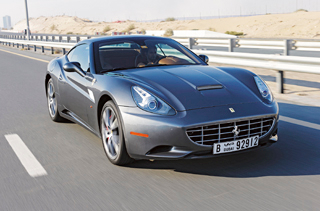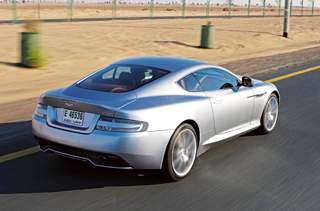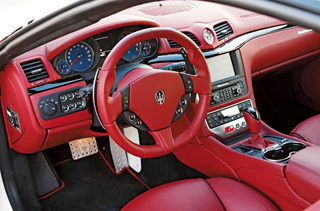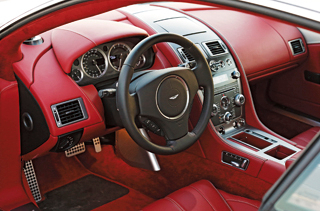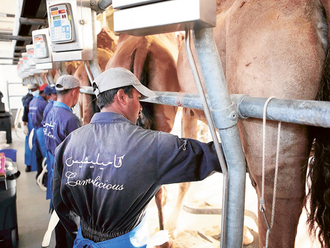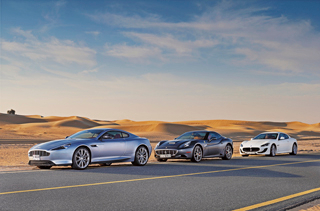
We have stopped to take in some fuel before we’ve even begun. Fifteen litres of cavernous cylinders, 28 of those in total, develop a remarkable and unquenchable thirst with three journalists behind the wheels, pockets lined with petty cash.
“Don’t forget to ask for the receipts!” Please, for Pete’s sake don’t forget the receipts. Our little convoy rests leisurely dotted around the petrol station; we nonchalantly occupy the place. Three million dirhams worth of cars do as they please — yellow lines are merely road decorations — and other cars don’t seem to mind. Every once in a while my Aston Martin DB9 graces a passerby’s vision. Strangely he’s not annoyed so much that I’ve blocked his path to the pump. The Aston’s 78-litre tank means there’s enough time for everyone to enjoy its timeless elegance.
So far the rev needles have been getting the hardest workouts — 6,500rpm in the DB9, 7,000rpm in the Maserati, and another 750rpm on top of that in the Ferrari arrive much too soon during short bursts from junction to junction. The low, long swathes of monochromatic metal tearing through Dubai are restless — these cars are caged animals here.
We’re heading out of the city to let them run free across the tarmac. A twist of a key, a press of a starter button, and a push of the Aston’s Emotion Control Unit (cringeworthy, yes, but you try not getting poetic with this thing), and we slither on to a brick road, 1,460 horsepower effortlessly breaking traction on the slippy surface and rev needles, once again bouncing in unison.
That 1,460 is pretty evenly distributed. The Aston leads with 510bhp, followed by the 490bhp California and 460bhp Maserati. All are fast. But it’s never the speed that thrills; it’s the impression of speed. Doing a hundred in the original Mini is exhilarating, yet add three times more weight, six times more power, triple the rubber contact patch on the road, and you need to be knocking at 250kph to start asking yourself if perhaps the front end is starting to lift a little, or if that’s just your imagination.
These cars just hunker down and go. I watch from the Aston how hard the suspension has to work even on a seemingly straight, flat desert road — the California’s and Maserati’s 20in rims and tyres furiously oscillate inside their wheels. The cars’ bodies look perfectly still, as if suspended on top of a giant paved treadmill moving at a million miles an hour. We swap positions and dance across two lanes of road giving each other childish thumbs up and encouraging gestures — hand signals for “rev it”, “step on it”, and “three, two, one” countdowns for the rolling-start sprints.
Perhaps to anyone flying high above us we must look like playful little water striders. And then we get nearer to the photoshoot location, and the desert slices the highway off. I seem to remember that our previous journeys to this place took much longer. In alternating howls, the two V8s and a sole V12 bounce off their rev-limiters as three drivers with perhaps too little mechanical sympathy down-shift three or four times for a roundabout.
Turn the wheel of any of these GT cars for a tight corner, and you need only a few degrees to hug the inside. On a fast cruise, though, the steering settles confidently in your hands, with no hopping of the wheel or slipping through your fingers. You don’t need to hang on to it like you would in a front-light mid-engined supercar. Past a narrow sand-strewn lane, dotted with sweeping bends and subjected by the desert into dozens of blind crests — jumps, in the case of 300kph GT cars — our machines apparently flip a switch and morph from cruisers into carvers.
There’s no bottoming out or heavy thuds over these crests, just the linear soaking up of bumps and fully composed suspension behaviour. For a moment when the steering wheel goes light in my hands in the Aston, I might waver a bit left or right in that split second of flight, but the huge tyres settle back down to earth and bite hard, the steering wheel immediately pointing straight ahead again.
Drama in these GTs comes from the fervent pull of horsepower and the shriek of the exhaust, the cars’ authoritarian command of the road never in question, be it an arrow-straight highway or tarmac influenced by this rolling terrain. This is not situational drama; it’s not a dangerous thrill. A Ferrari 458 Italia frightened me in the hills of Hatta. A Gran Turismo, DB9 or California are risk-free investments into driving enjoyment.
All of these cars are about 200kg too heavy to be considered supercars, and the 1,785kg Aston heads the table. It’s a testament to Gaydon’s aluminium expertise, however, that even with a mammoth 6.0-litre V12 the DB9 is only 5kg heavier than the 4.7-litre V8-engined Maserati. The Ferrari, with its athletic 4.3-litre V8 revs as free and as frictionlessly as a pinwheel — a flat-plane crankshaft accounts for some of that.
Maranello used aluminium in this upgraded California’s chassis extensively, and cut 30kg from the car’s weight. Even with a hefty and electrically operated hard-top roof the Ferrari tips the scales at 1,735kg. Our tester includes magnetorheological dampers that make the California as easy to drive as a Mercedes SLK. The Aston is stiff and on edge, rides very firmly, and its large-capacity engine loses nothing in instant throttle response to the smaller, quicker V8s.
But due to the number of cylinders the 510bhp Aston motor is able to afford a relatively short stroke and so rev up like mad. The Maserati shares the bore dimension of the Ferrari’s engine, and the Trident’s factory only had to increase the stroke of the pistons to a quite long 84.5mm in order to add the 400cc of extra capacity.
Yet the Maserati struts around shooting its mouth off louder than anything this side of straight-through exhaust pipes. But where a hot-cam racecar engine burps and spits, gargling fuel and drooling all over the place, the Gran Turismo holds high notes that would have brought tears to Pavarotti’s eyes. The Maserati is the Fourth Tenor. And then you hit the exhaust valve ‘Sport’ switch...
Jumping back into the DB9 after the feminine California, the Aston starts cornering stupidly flat, while my face is busy getting rearranged — a suggestion that the substantial masses involved are constantly shifting around the car’s axes. There’s lots of weight here to loll about, and it’s apparent, yet the car’s suspension doesn’t seem to be that bothered. For a GT, the DB9 is borderline supercar.
It’s not as usable as the California, or perhaps as showy as the Maserati, but it’s the lineback of the team. The muscle. It’s just got a very good tailor. We’re swallowing the road on the way back, blurring the landscape, and reeling in the horizon. But all is calm with the world, from the inside at least. These cars are impeccably and luxuriously appointed in the cabins, although not always very logically.
Maserati, for example, probably thinks its blue-faced dials look great, and they do, but they aren’t much good for seeing what lights are illuminated. That won’t bode well if you’re pottering along for weeks with your engine check light begging for attention. Ferrari, on the other hand, uses a display and infotainment system with satellite navigation that looks suspiciously similar to the one in a Chrysler Grand Voyager minivan, and Aston Martin’s system is so bad you may as well forget it’s there at all.
Which is easy, because it’s nigh-on impossible at times to get the electronics to even respond to your attempts at raising the screen. The cupholders are no good too, but deep holes in the transmission console would’ve spoiled the stately look, as would decent switchgear that human fingers could actually press, because the sleek buttons and steel knobs on the DB9’s centre console look amazing, and that’s what counts. After all, a Fabergé egg isn’t much good in an omelette either. Facets of these cars are art for art’s sake.
But automotive art is the only kind I know that you can jump into, fire up, and disappear in, chasing empty desert roads. No philosophising necessary, no “I wonder what the artist was thinking…”, just step on it and let function take over their form, for once. Right up until the fuel warning light comes on. Let’s hope you remember the receipt.


